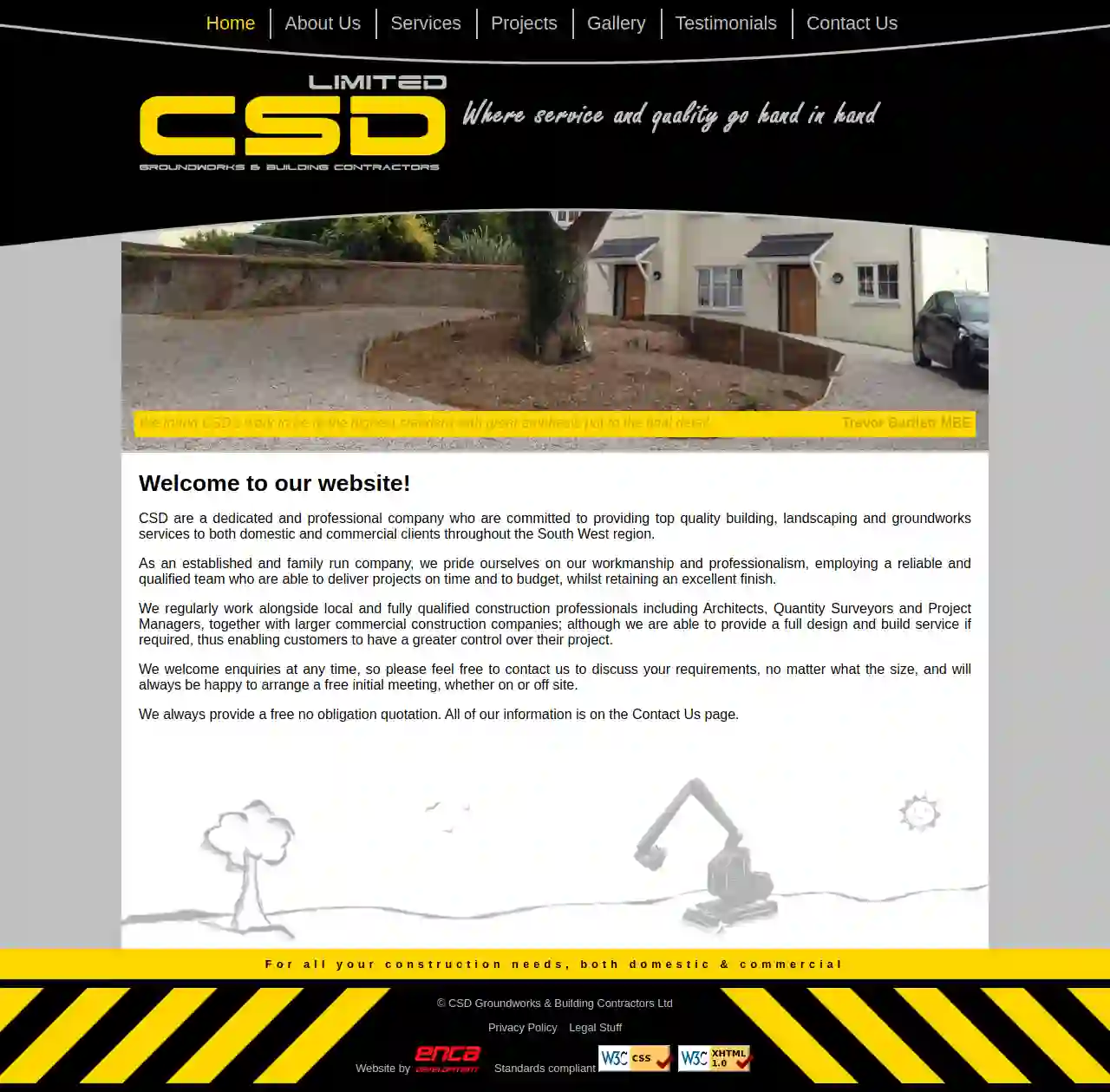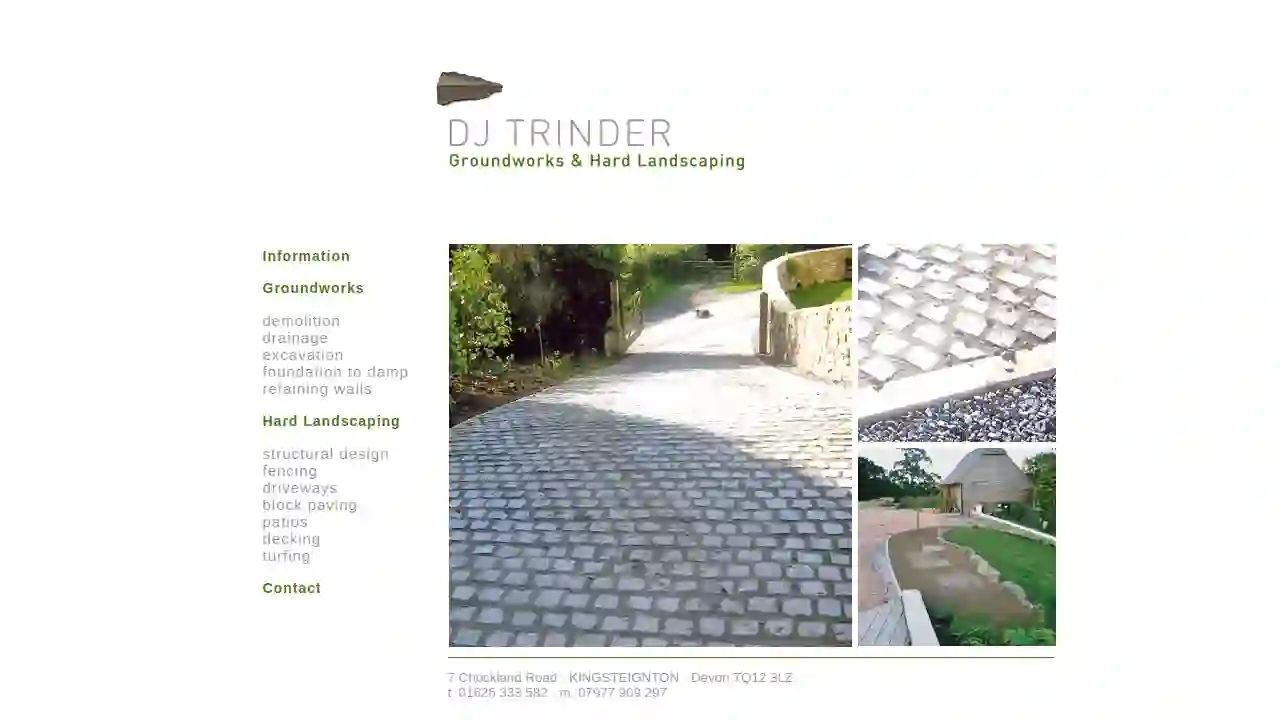Excavation Contractors Sidmouth
Find Excavating Contractors in Sidmouth
Get 3 FREE Excavation Contractors Near Me quotes for your project today! Compare profiles, reviews, accreditations, portfolio, etc... and choose the best service.

CSD Groundworks & Building Contractors Ltd
51 reviewsExeter, GBAbout CSD CSD Groundworks & Building Contractors Ltd is a dedicated and professional company committed to providing top-quality building, landscaping, and groundworks services to both domestic and commercial clients throughout the South West region. Established and family-run, we take pride in our workmanship and professionalism, employing a reliable and qualified team capable of delivering projects on time and within budget, while maintaining an excellent finish. We regularly collaborate with local and fully qualified construction professionals, including Architects, Quantity Surveyors, and Project Managers, alongside larger commercial construction companies. We can also provide a full design and build service if required, giving customers greater control over their projects. We welcome inquiries at any time. Feel free to contact us to discuss your requirements, regardless of size. We're always happy to arrange a free initial meeting, whether on or off-site. We also offer free, no-obligation quotations.
- Services
- Why Us?
- Accreditations
- Testimonials
- Gallery
Get Quote
Knowle Hill Recycling Centre
3.549 reviewsKnowle Hill Recycling Centre, Exmouth, Knowle Hill Recycling CentreExmouth, EX8 5BP, GBKnowle Hill Recycling Centre Knowle Hill Recycling Centre is a convenient and efficient way to dispose of your unwanted waste. We offer a wide range of services, including: Recycling of a wide range of materials Disposal of chargeable waste A reuse shop where you can purchase reusable goods A van permit system for commercial vehicles We are committed to providing a safe and efficient service for all our users. Our site staff are on hand to provide assistance when reasonable, but they are unable to lift excessively heavy and/or awkward loads. Please ensure that your waste is separated before arriving at the site.
- Services
- Why Us?
- Gallery
Get Quote
D J Trinder Groundworks
7 Chockland Road, KINGSTEIGNTON, TQ12 3LZ, GBAbout DJ Trinder DJ Trinder is a family-run business with over 20 years of experience in the construction industry. We offer a wide range of services, from groundworks and demolition to landscaping and fencing. We are committed to providing our clients with high-quality workmanship and excellent customer service. Our Services We offer a wide range of services to meet your needs, including: Groundworks Demolition Drainage Excavation Foundation to damp Retaining walls Hard Landscaping Structural design Fencing Driveways Block paving Patios Decking Turfing Our Team Our team of experienced and qualified professionals is dedicated to providing you with the best possible service. We are committed to working closely with our clients to ensure that their projects are completed to the highest standards. Our Commitment We are committed to providing our clients with: High-quality workmanship Excellent customer service Competitive prices A professional and reliable service
- Services
- Why Us?
- Gallery
Get Quote
A and M Groundworks | Building Contractors Exeter
3.928 reviewsExeter, GBGroundworks Contractors in Exeter Initiating any construction project begins with establishing a solid foundation. This process involves deep excavations, levelling, grading, soil stabilisation, and the installation of underground drainage systems. Achieving robust groundwork requires meticulous attention to detail, expert supervision, and precise execution – hallmarks of A&M Groundworks. With a wealth of experience in delivering top-notch groundworks in Exeter, we handle a wide range of projects, helping private and public sectors augment land utilisation by employing state-of-the-art technology. Contact us for a quote and discuss your project with our professional engineers to achieve the highest quality finish at the most competitive price. More About Us 15 Years Experience Services Bespoke Work by Craftsmen
- Services
- Why Us?
- Testimonials
- Gallery
Get Quote
CAB Construction SW LTD
51 reviewsExeter, GBTransforming the South West with Timely, Efficient & Affordable Construction Solutions At CAB Construction SW Ltd, we are your reliable and experienced construction partner, catering to projects of all sizes across the South West of England. Whether it’s a small residential renovation or a large-scale commercial development, we have the expertise to deliver outstanding results. ABOUT US: As a fast-growing, family-run business based in Okehampton, Devon, we take immense pride in serving both domestic and commercial clients. With over 25 years of combined experience in the building and construction industries, our skilled team has forged strong partnerships with main contractors, local authorities, and private developers. RELIABLE SERVICE: The success of your project is our priority. We value prompt and responsive communication, ensuring your needs are met and deadlines are achieved. Count on us to deliver projects on time and within budget. EXPERTISE YOU CAN TRUST: When you choose CAB Construction SW, you benefit from the wealth of knowledge and experience possessed by our team. Across various sectors, we have tackled diverse construction challenges, making us adept at handling any project with precision and efficiency. FULLY INSURED FOR YOUR PEACE OF MIND: Safety and meticulous planning are ingrained in every aspect of our work. We are fully insured with Public Liability Insurance, assuring the protection of your property and work site throughout the construction process. No matter the scale of your project, CAB Construction SW is committed to providing the highest standard of service, superior craftsmanship, and attention to detail. Partner with us and let’s turn your construction vision into reality.
- Services
- Why Us?
- Testimonials
- Gallery
Get Quote
Devon Minor Works
56 NEWCOURT BARTON CLYST RD EXETER, Exeter, EX3 ODB, GBWelcome to Devon Minor Works – the leading name in Building & Maintenance. Serving the people and organisations of Exeter and Devon for over 25 years. For nearly 25 years we have been dedicated to the highest levels of service in small build, refurbishment, repair and maintenance. Our website aims to provide you with all you need to know about our service and please do get in touch if you have a project in mind. Customers often ask what we mean by ‘minor works’. The answer: when your job is probably too small for large, and often impersonal, companies, and when you’re still looking for the same level of service and professionalism, that’s where Devon Minor Works fits in – flexible, friendly and sensibly priced for contracts up to £50,000. We take pride in being exclusive to Exeter and Devon! We pride ourselves on being a local company; this is our home, our place of work and where we stand or fall by our long term reputation. It’s reassuring to know that Devon Minor Works is a member of the Federation of Master Builders, the leading standard for quality and good working practice. And A Member of the Painting and Decorating Association. Steve Coomber – Director Managing Director, Steve Coomber has lived in Exeter all of his life and is well known as a charming and dedicated professional, as well as for his charitable works in the City. “But Steve wishes you to know that he didn’t write this bit!!” – Aylwyn Bowen – Exeter Street Art.
- Services
- Why Us?
- Our Team
- Gallery
Get Quote
Exeter and Plymouth winter gritting contractors
Unit 1, The Old Dairy, Topsham, GBAbout County Grounds Maintenance County Grounds Maintenance is a dedicated team of experts in all things outdoors, providing a comprehensive range of commercial grounds maintenance services. We are committed to delivering high-quality, reliable, and professional services to our clients, ensuring their outdoor spaces are well-maintained and aesthetically pleasing. We understand the importance of a well-maintained outdoor environment, and we strive to provide our clients with the best possible service. Our team is highly skilled and experienced, and we are equipped with the latest tools and equipment to ensure that all our work is completed to the highest standards. Whether you need help with soft landscaping, hard landscaping, winter services, site clearance, grass services, tree and hedge services, or turfing, seeding, and wildflower meadows, we have the expertise and resources to meet your needs. We are committed to providing our clients with a personalized service that is tailored to their specific requirements. We take pride in our work and are committed to providing our clients with a high level of customer service. We are always happy to answer any questions you may have and provide you with a free, no-obligation quote.
- Services
- Why Us?
- Gallery
Get Quote
SSBC Contractors Ltd
56 reviewsSSBC Unit 10, Summers Yard, Caddsdown Industrial Estate, Bideford, North Devon, EX39 3GE, GBSSBC – Building & Carpentry Contractors SSBC Building and Carpentry Contractors is a renowned one stop company for all your building and construction needs. We provide all construction services in-house and undertake all types of construction services that include new builds, extensions, renovations and general property maintenance. Over the years, as we have evolved into a complete building services for domestic and commercial clients. We aim to provide affordable and professional services throughout Devon, Cornwall and Somerset. We are fully committed to providing our clients with services that exceed their expectations and ensure they receive the best possible added value. We take pride in every job we do and work hard to provide the very best quality and finishes.
- Services
- Why Us?
- Gallery
Get Quote
Render Dry Ltd
5 Heath Hill, Heathfield, Newton Abott, Devon, TQ12 6SP, GBRender Dry Ltd Render Dry Ltd is a complete building and property maintenance service covering the South West. We offer a design and build service to suit all budgets, with a quality team of builders specializing in extensions, renovations, loft conversions, and barn conversions. We have many years of experience in the construction industry and cover all trades using our own team of tradesmen and local subcontracted tradesmen. We have worked with many clients in the South West on various projects, from maintenance contracts for Nursing Homes and Residential care homes to domestic clients seeking to build extensions, convert lofts, garages, and barns. We have also carried out many insurance contracts for a local loss adjuster firm and carry out many building repairs, ranging from leaking gutters to complete renovations. If you are looking for reliable, affordable, local, top quality tradesmen, then Render Dry are the team you need. We offer a complete building and maintenance service for commercial and domestic properties. Covering the South West. Design and build service to suit all budgets. Extensions, renovations, loft conversions, barn conversions. Please get in touch to discuss your requirements, as we're sure we can help.
- Services
- Why Us?
- Testimonials
- Gallery
Get Quote
Exeter Property Services
55 reviewsExeter, GBExceptional Home Remodelling & Restorations Exeter property services provide a free estimate service for any work you may require and can offer guidance and advice for all your maintenance and home improvement needs. Whether you require a new kitchen or just some shelving put up you will receive the same professional service. Why Choose Us Professional service for all works provided inside and outside the home. Free, At Home Consultations including specific guidance and advice for your work. Over thirty years experience in property maintenance, home improvements and building. Fully Insured - You are in safe hands with Exeter property services.
- Services
- Why Us?
- Testimonials
- Gallery
Get Quote
Over 13,059+ Excavation Companies onboarded
Our excavation contractors operate in Sidmouth and beyond!
ExcavationHQ has curated and vetted the Best Excavation Contractors near Sidmouth. Find the most trustworthy pro today.
Frequently Asked Questions About Excavation Contractors
- Soil Type and Stability: Stable, cohesive soils allow for deeper excavations than loose or unstable soils.
- Groundwater Level: Excavations below the water table require dewatering techniques to manage water intrusion.
- Equipment and Resources: The size and capabilities of excavation equipment influence the achievable depth.
- Safety Regulations: OSHA and other safety regulations impose limitations on trench depths without proper shoring or sloping.
- Project Requirements: The purpose of the excavation (basement, pool, foundation) determines the necessary depth.
- Clear the Area: Remove any obstacles, including vehicles, outdoor furniture, landscaping features, or structures, from the excavation zone and surrounding area.
- Mark Existing Features: Identify and mark underground utilities, septic tanks, sprinkler systems, or other buried elements you want to protect.
- Protect Landscaping: Use tarps or fencing to shield trees, shrubs, gardens, or other landscaping elements from damage.
- Provide Access: Ensure the excavation contractor has clear access to the work area, including gates wide enough for equipment.
- Discuss Logistics: Coordinate with the contractor regarding parking arrangements, material delivery, and any special instructions or concerns you might have.
- Project Size and Scope: The larger and more complex the excavation, the higher the cost.
- Soil Type: Different soil types require different equipment and techniques, impacting costs. Rocky or clay-rich soil can be more expensive to excavate than loose soil.
- Accessibility: Difficult-to-access sites might require specialized equipment or additional labor, increasing expenses.
- Disposal Costs: Hauling away excavated material (soil, rocks, etc.) to disposal sites incurs additional fees.
- Permits and Inspections: Depending on local regulations, permits and inspections might be required, adding to the overall cost.
- Spring and Fall: Often considered favorable due to moderate temperatures and drier soil conditions.
- Summer: Can be suitable, but hot weather can make working conditions challenging and might require additional measures (shade, hydration) for workers.
- Winter: Excavation in winter can be more difficult due to frozen ground, snow, and potential delays caused by inclement weather. It might also require specialized equipment or techniques.
How deep can you excavate?
How do I prepare my property for excavation?
How much does excavation cost?
What is the best time of year for excavation?
How deep can you excavate?
- Soil Type and Stability: Stable, cohesive soils allow for deeper excavations than loose or unstable soils.
- Groundwater Level: Excavations below the water table require dewatering techniques to manage water intrusion.
- Equipment and Resources: The size and capabilities of excavation equipment influence the achievable depth.
- Safety Regulations: OSHA and other safety regulations impose limitations on trench depths without proper shoring or sloping.
- Project Requirements: The purpose of the excavation (basement, pool, foundation) determines the necessary depth.
How do I prepare my property for excavation?
- Clear the Area: Remove any obstacles, including vehicles, outdoor furniture, landscaping features, or structures, from the excavation zone and surrounding area.
- Mark Existing Features: Identify and mark underground utilities, septic tanks, sprinkler systems, or other buried elements you want to protect.
- Protect Landscaping: Use tarps or fencing to shield trees, shrubs, gardens, or other landscaping elements from damage.
- Provide Access: Ensure the excavation contractor has clear access to the work area, including gates wide enough for equipment.
- Discuss Logistics: Coordinate with the contractor regarding parking arrangements, material delivery, and any special instructions or concerns you might have.
How much does excavation cost?
- Project Size and Scope: The larger and more complex the excavation, the higher the cost.
- Soil Type: Different soil types require different equipment and techniques, impacting costs. Rocky or clay-rich soil can be more expensive to excavate than loose soil.
- Accessibility: Difficult-to-access sites might require specialized equipment or additional labor, increasing expenses.
- Disposal Costs: Hauling away excavated material (soil, rocks, etc.) to disposal sites incurs additional fees.
- Permits and Inspections: Depending on local regulations, permits and inspections might be required, adding to the overall cost.
What is the best time of year for excavation?
- Spring and Fall: Often considered favorable due to moderate temperatures and drier soil conditions.
- Summer: Can be suitable, but hot weather can make working conditions challenging and might require additional measures (shade, hydration) for workers.
- Winter: Excavation in winter can be more difficult due to frozen ground, snow, and potential delays caused by inclement weather. It might also require specialized equipment or techniques.